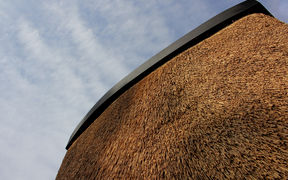A visual artist wielding more than a hammer

Science and culture work together to imagine the future, says Artist in Residence Matthew C. Wilson. He refers to director Stanley Kubrick’s consultations with artificial intelligence pioneer Marvin Minsky, held in order to develop HAL 9000, the infamous AI character in the film 2001: A Space Odyssey.
“Now we talk to Siriand Alexa, but we needed the film to prepare us for their arrival.”
Wilson appreciates the fact that Aalto University places art alongside science and other forms of research, adding
“If we somehow detach our tools from their specific discipline, we can discover new uses for them.”
Complex problems, different perspectives
According to Wilson, artistic research and practice are as significant as scientific work, but employ different methodologies and sensibilities towards different outcomes.
“If all you have is a hammer, everything looks like a nail. With more tools, you might approach and solve problems differently. Addressing complex problems—like those we face today—requires not one tool, but a toolkit.”
Wilson’s current research includes “future imaginaries”—collective image pools, ideas, institutions, and ideologies that transform the world.
“The future always springs from history. We live in a world that was once only imaginary. In the process of realising images of the future, there are always unintended consequences. Art and culture address those consequences, before and after they appear—bridging histories and futures. Science and culture are involved in the same processes of imagining and transforming.”
Do we underuse our ability to imagine?
Wilson agrees that science needs methods and structures, but believes there are moments when limitations and boundaries are reached. He ponders the history of non-analytical techniques for engaging with these boundaries.
“There is a long list of scientists and innovators whose ‘aha’ or ‘eureka’ moments do not come exclusively from analytical processes—these range from Friedrich Kekulé’s claim that a dream of a snake biting its own tail provided insight into the structure of benzene to Alfred Russel Wallace who, independently of Darwin, conceived of evolution by natural selection during a malarial fever.”
Wilson also wonders about the present and future potential of mental states where hitherto unknown objects, images, and processes can be brought into focus.
“We commonly think moments of insight result from background mental processes, but actually, active foregrounding of the scenario, simulating and modelling capacities of the mind, can be integral to grasping complex phenomena and elusive forms.”
Wilson describes how the inventor Thomas Edison “visualised the future” by holding steel balls in his hands that would drop if he fell asleep, awakening him just in time to catch insights from hypnagogia—the state on the edge of sleep.
Experimental processes causing tension
Formerly both a computer engineering and literature student, and now turned artist Wilson has a longstanding engagement with discourses and methods outside art.
“I’ve always been interested in anthropology and its method of participant observation—this idea that you can be in multiple positions or roles at a time, which need not negate each other even if those experiences are irreconcilable.”
When starting a dialogue or collaboration with scientists or researches from different fields, Wilson wants to understand not only the materials and methods of their work, but also the motivation behind it. Asked about his own motivation, Wilson said,
“It’s a common idea that art is supposed to make your life better, bring beauty or enjoyment. This can be true, but harmony is often found by first making ourselves uncomfortable and uncertain, by struggling to re-evaluate existing perceptions. I produce work that invites this process.”
Matthew C. Wilson holds a Master of Fine Arts degree from Columbia University. He is a visual artist who makes videos and sculptures exploring natural, historical, economic, and perceptual processes. As Aalto University’s artistin residence, he will develop an artistic project in the schools of Chemical Engineering and Science and give lectures in the University-wide Art Studies minor.
Aalto University’s Artist-in-Residence Program produces artworks stemming from a dialogue between art and science. During this residence, the artist will pursue her or his own creative project while at the same time engaging with the Aalto community in various ways. The outcome of the residence period will be premiered in the Helsinki region. The program, established in 2011, has welcomed altogether five artists to date.
Text: Tiina Toivola
Photo: Mikko Raskinen
Artist-in-Residence Programme
The Aalto AiR programme follows the practices of the best international universities and is, notably, the first of its kind in the Nordic countries.

Read more news

Your voice gives away valuable personal information, so how do you keep that data safe?
With speech technologies becoming increasingly common, researchers want to make sure we don’t give away more information than we mean to.
Aalto in 2025: Quantum leaps, creative breakthroughs and solutions for a better life
Growth, technology and industrial renewal; human-centred solutions; health and everyday wellbeing; and enjoyable daily life and thriving communities.
Bring your child to work day 2025 at the Department of Applied Physics
The Department of Applied Physics encouraged employees to bring their children to work on 21. November 2025- you can have a peak at what kids did on that day






